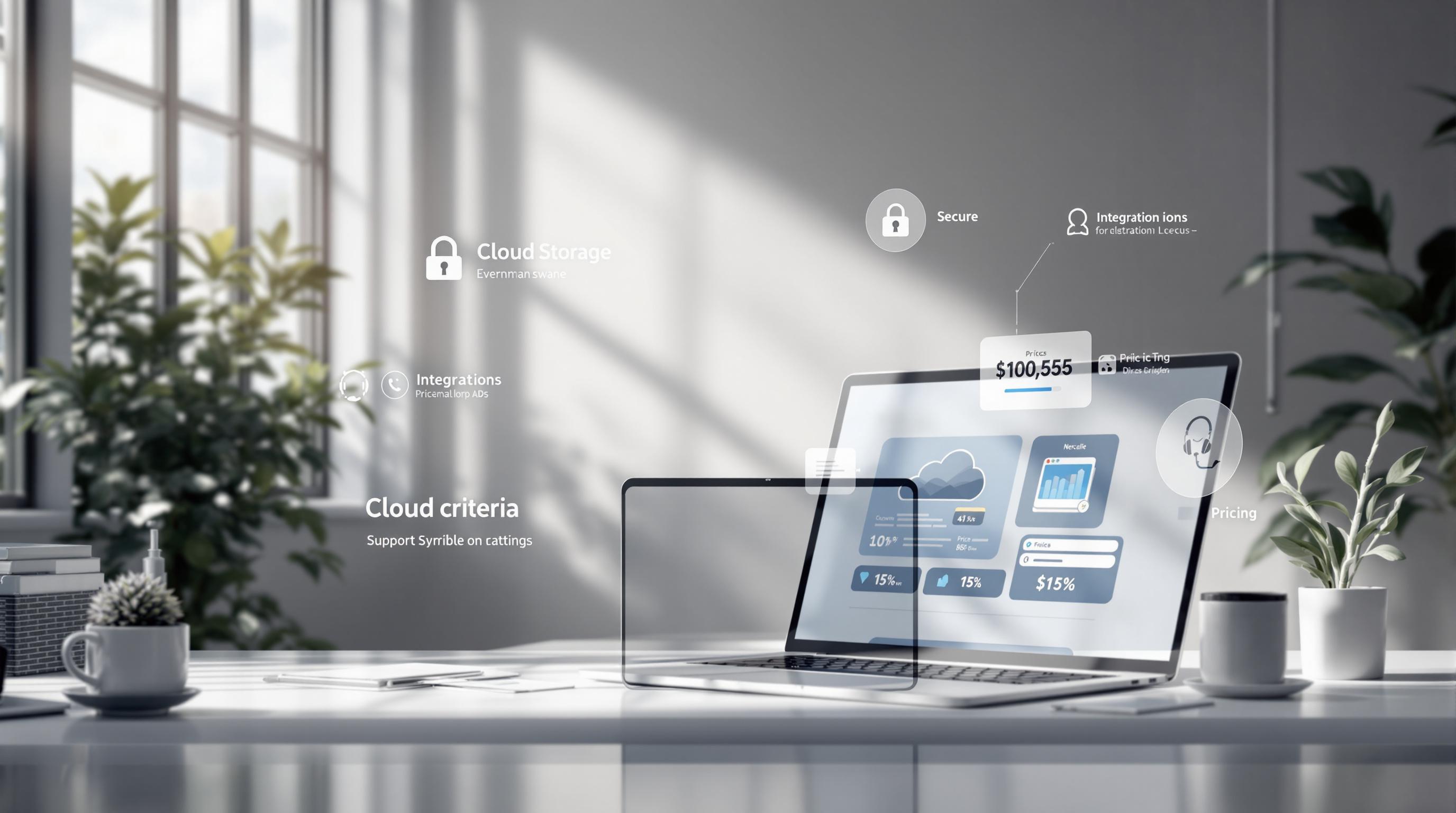File management and board meeting tools work best when integrated. This combination simplifies document sharing, improves meeting preparation, and enhances security. Here's how it works:
- File Management Systems: Organize, store, and secure documents. Features like centralized storage, version control, and access permissions keep everything in order.
- Board Meeting Tools: Handle agendas, voting, and minutes while ensuring transparency and accountability.
- Integration Benefits:
- Saves time by syncing documents automatically across platforms.
- Strengthens security with unified access controls and audit trails.
- Streamlines compliance with automated retention policies and reporting.
Key Features include automated agenda creation, task tracking with file linking, and e-signatures for quick approvals. By combining these tools, organizations can simplify processes, improve collaboration, and maintain secure governance.
Boardable Q4 Release: AI Minutes, Surveys & Microsoft Integration
Step-by-Step Guide to Integrating File Management with Board Meeting Tools
Integrating file management with board meeting tools can transform how documents are shared and accessed during meetings. With secure upload options and user-friendly interfaces, you can organize materials efficiently and ensure everything is ready when needed. Here’s how to set up and use these features effectively.
Initial Setup and Configuration
Start by connecting your systems. Go to the integration settings in your board meeting platform, locate the file management section, and authenticate your document repository using API credentials or single sign-on (SSO).
Next, structure your folders to match your board’s needs. Consider creating dedicated folders for:
- Board packets and agendas
- Financial reports and audits
- Legal documents and contracts
- Meeting minutes and recordings
Set up synchronization preferences to keep files updated across platforms. Enabling real-time sync ensures that any changes made to documents are immediately reflected in the meeting interface.
Uploading and Organizing Files
From your integrated dashboard, select the board file repository. Use the bulk upload feature to add multiple files quickly, and confirm that all documents sync automatically with the meeting interface.
Maintain order by using consistent naming conventions like "YYYY-MM-DD_DocumentType_Version." This makes it easier to locate files. Tagging documents with categories such as "Financial", "Strategic", or "Compliance" can also simplify filtering and searching.
To save time, create templates for recurring materials like meeting agendas or minutes. These templates can be linked to populate future meetings with pre-formatted content.
Data Security and Compliance Setup
Set access permissions based on roles. For instance, board members might have read-only access, while administrators retain full editing rights.
Enable audit logging to monitor document activity, including access, changes, and downloads. You can also automate compliance reports to track governance activities and meet regulatory requirements.
Finally, establish retention policies to manage documents over time. Set rules to archive or delete files according to your organization’s standards, and schedule regular security reviews to ensure ongoing compliance with data protection regulations.
Benefits of File Management and Board Meeting Tool Integration
When file management systems integrate with board meeting tools, the result is a smoother, more efficient workflow. This combination helps organizations cut down on administrative hassles and streamline board operations, making it easier to focus on what truly matters.
Improved Efficiency
With centralized storage, all your documents are in one place, ready for easy access. Board secretaries only need to upload a document once, and it’s automatically available within the meeting interface.
Meeting packets come together quickly using pre-set templates, with documents auto-filling based on configurations. Plus, version control ensures everyone is always working with the latest updates.
Need to find something fast? Advanced search tools make locating key information a breeze, keeping discussions on track. Pre-meeting alerts also help ensure board members review materials on time, leading to more informed conversations and quicker decisions. This boost in efficiency naturally enhances collaboration, too.
Enhanced Collaboration
Real-time document sharing allows board members to work together effortlessly. Whether they’re in the same room or spread across different time zones, updates appear instantly on all devices.
Features like annotations and comments let members highlight sections, ask questions, or leave feedback directly within documents. This means smaller issues are resolved before meetings, leaving more time for strategic discussions.
Version control eliminates confusion by keeping everyone on the same page - literally. Only the latest, approved version of a document is shared with participants.
And with mobile access, board members can stay connected no matter where they are. Whether on a smartphone, tablet, or laptop, the tools work seamlessly, supporting flexible and modern governance.
Strengthened Governance and Compliance
Audit trails automatically record every action taken on a document, making it easier to maintain transparency and accountability. Compliance is simplified with automated monitoring and retention policies that align with both organizational and legal standards, reducing the chance of human error.
Access controls help maintain security by assigning permissions based on roles. For example, guests might only have read-only access, while administrators have full control.
Finally, integrating these systems streamlines regulatory reporting. Reports can pull data directly from meeting records and financial documents, cutting down on manual work and reducing the risk of errors. This makes it easier to meet compliance requirements without adding extra administrative headaches.
Key Features That Support Productivity
The right tools can revolutionize how boards operate, shifting the focus from time-consuming administrative tasks to strategic decision-making.
Automated Agenda Creation
Gone are the days of spending hours manually crafting meeting agendas. AI-powered agenda builders now make it possible to generate professional, structured agendas in just seconds. All you need to do is provide a brief description of the meeting or share existing content, like email threads, and the tool does the rest.
For instance, an AI-powered agenda tool allows users to describe their meeting in plain, everyday language or paste relevant materials. The system then creates a well-organized agenda almost instantly. As one platform explains:
"Agenda AI, you can describe your meeting in plain language - or paste in source materials like email chains - and get a thoughtfully structured agenda in seconds. It's fast, flexible, and built to help every board meeting start with purpose."
These tools also include context-aware generation, which considers participants, objectives, and organizational priorities to ensure that the most pressing issues are addressed first. Time-boxing features allocate specific durations for each topic, while customizable templates maintain consistency across different meetings. Once the agenda is set, integrated task management tools ensure follow-through on the planned discussions.
Task Management and File Linking
After automating agendas, keeping track of tasks and related files becomes the next priority. With integrated task management features, you can assign responsibilities, set deadlines, and link relevant documents - all within a single platform.
Real-time action-item capture tools streamline this process. During meetings, users can log action items, assign ownership, and set deadlines directly in the minutes editor. This instant documentation ensures that nothing is missed or miscommunicated.
What’s more, tasks are automatically connected to supporting documents. For example, if someone is assigned to review financial projections, the relevant spreadsheets and reports are linked directly to the task. Notifications ensure team members have all the materials they need, eliminating the hassle of chasing down files through emails.
Deadline tracking is visual and automated, with dashboards showing upcoming due dates, overdue items, and the status of tasks. Some platforms even include AI tools that flag incomplete tasks and suggest follow-up actions between meetings:
"Actions AI will help boards stay aligned between sessions - by flagging incomplete items, identifying follow-up needs, and bringing continuity to the decisions that matter most."
E-Signatures and Approval Workflows
Digital approvals have replaced the cumbersome process of printing, signing, scanning, and emailing documents. Integrated e-signature features within board management platforms now make it possible to approve documents in a fraction of the time.
For example, an e-signature tool allows users to upload documents needing signatures, notifying directors immediately. With one-click signing, the process is seamless and legally valid.
Approval workflows go beyond just signatures. Multi-step processes ensure documents are routed to the right people in the correct order. For instance, a policy change might require committee review, legal approval, and board ratification. The system automates this chain of approvals and tracks progress in real-time.
Integration with Microsoft’s platforms adds even more convenience. SharePoint and OneDrive files can be imported directly into board packets, and any updates made to these files automatically sync across the platform. This eliminates manual uploads and version confusion, keeping everything current.
Audit trails further enhance governance by logging every action - signatures, approvals, and document access included - with timestamps, IP addresses, and user details. This not only strengthens compliance but also simplifies reporting for governance teams. Regulatory requirements are met with minimal effort, reducing administrative work while ensuring transparency.
sbb-itb-d1a6c90
Best Practices for File Management in Board Meetings
Managing files for board meetings isn’t just about uploading documents - it’s about keeping everything organized and secure. A disciplined approach ensures that board materials are easy to find, well-structured, and protected.
Regular File Maintenance
Good file organization starts with clear and consistent naming conventions. For example, instead of vague names like "Budget_final_FINAL_v3", go for something like "FIN_Budget_2025_v2." Avoid using special characters, and stick to standardized file formats like PDFs. Adding 2–3 descriptive tags per document can also make searches faster and more efficient.
To streamline this process further, create a standardized list of abbreviations for commonly used terms. For instance, use "AM" for annual meetings, "FIN" for financial documents, and "HR" for human resources materials. Having a predictable system makes locating files much easier.
A well-thought-out tagging or folder system is another way to keep things organized. Grouping documents logically and using a handful of relevant tags ensures quick access without creating unnecessary complexity.
Setting Up Access Policies
Protecting sensitive information while ensuring the right people have access is crucial. Implement multi-layered security measures, such as SOC2-certified infrastructure, to safeguard board communications.
Your organization’s bylaws should detail how meeting minutes are stored and outline procedures for handling public records requests. These policies should be reviewed annually to stay aligned with any regulatory changes or organizational shifts.
Role-based permissions are another key element. For instance, committee chairs might need access to all committee-related files, while executive session materials should remain restricted to specific individuals. Independent directors may require different access levels than management representatives. These clear permissions not only enhance security but also support real-time collaboration, fitting seamlessly into an integrated governance strategy.
Distributing board materials in advance is also a good practice. Board packets - typically including the agenda, unapproved minutes, committee reports, proposed actions, and supporting documents - should be sent out well ahead of meeting dates. This gives members ample time to prepare.
Mobile Access Setup
Board members often need secure access to files on the go. Mobile-friendly platforms ensure that security protocols remain consistent across devices while enabling collaboration from anywhere.
Using standardized templates improves navigation on mobile devices, making it easier for members to review materials and make informed decisions, even on smaller screens. Offline access is another essential feature - documents should sync automatically once an internet connection is restored, allowing board members to stay productive even in areas with poor connectivity.
After meetings, it’s important to share draft minutes and key outcomes promptly. Mobile notifications can alert members when new materials are available, and mobile-friendly formats make it easy to check action items and deadlines while on the move.
Conclusion
Bringing file management and board meeting tools together can revolutionize how boards operate. This integration creates a smooth workflow, allowing documents to move effortlessly from creation to distribution, review, and archival - all without jumping between platforms.
The advantages of this approach are undeniable. Automation replaces time-consuming manual tasks like transferring files or building agendas from scratch, boosting efficiency. Additionally, built-in security features, audit trails, and standardized workflows help organizations stay compliant with regulatory demands.
Features such as automated agenda creation, task tracking, and simplified approval processes significantly cut down on administrative work. When paired with best practices like consistent file naming, role-based access, and mobile-friendly configurations, these systems become indispensable tools for running effective board operations.
For organizations aiming to modernize, merging file management with meeting tools isn't just about adopting new technology - it's a smart move toward improving board governance. The added layers of security and compliance offer reassurance in a world with ever-evolving regulations.
This integration doesn't just streamline processes; it creates a governance model that's more efficient, transparent, and secure, ensuring all stakeholders have easy access to what they need. It’s a step toward a more unified and agile way of managing board responsibilities.
FAQs
How does integrating file management with board meeting tools improve security and compliance?
Integrating file management with board meeting tools strengthens security and ensures compliance by keeping sensitive documents in a centralized, protected space. With features like encryption, access controls, and audit trails, these tools make sure that only the right people can access or modify important files.
This setup also streamlines compliance with regulatory standards by simplifying how documents are tracked and handled. By minimizing the risk of data breaches and ensuring proper management of confidential information, it helps leadership teams maintain legal standards and confidently oversee sensitive operations.
How do I integrate file management with board meeting tools, and what steps ensure a seamless setup?
Integrating File Management with Board Meeting Tools
To combine file management with board meeting tools effectively, start by selecting software that offers integration options, whether through built-in features or APIs. Once you've identified the right platform, map out a detailed implementation plan. This should include steps like migrating data, setting up user permissions, and configuring access levels to ensure everything runs smoothly.
Bring key stakeholders into the process early to align goals and expectations. Hold off on sending user invitations until the system is fully configured and ready to go. It's also a good idea to designate at least two administrators with full access to handle any unforeseen issues. To help your team adjust, schedule regular training sessions and provide ongoing support. Clear communication throughout the process will minimize disruptions and pave the way for a seamless transition.
What are the best practices for keeping files organized and secure within board meeting tools?
To keep your file management system organized and secure within board meeting tools, start with robust security protocols. This means using encryption to protect data, implementing multi-level access controls to restrict who can view or edit files, and monitoring activity to track any unauthorized changes.
Next, create a clear folder structure and stick to consistent naming conventions. This makes it easy for everyone to find the documents they need without confusion. Always deliver meeting materials ahead of time so participants have enough time to review and prepare.
Regularly archive files that are no longer active, and store everything in a centralized repository. This ensures quick access to important documents while keeping the system clutter-free. These steps not only simplify collaboration but also enhance accessibility and keep sensitive information secure during board meetings.


